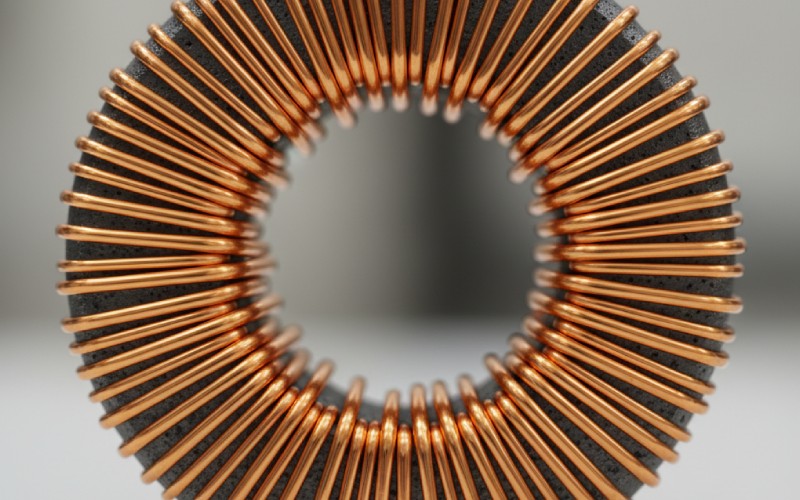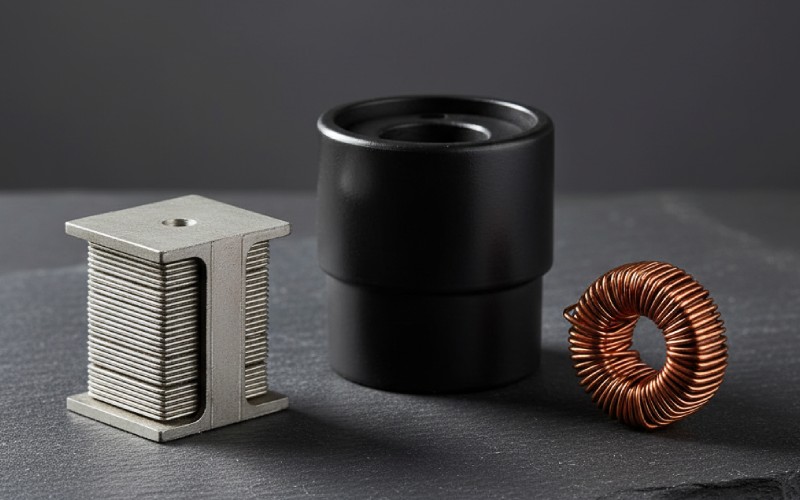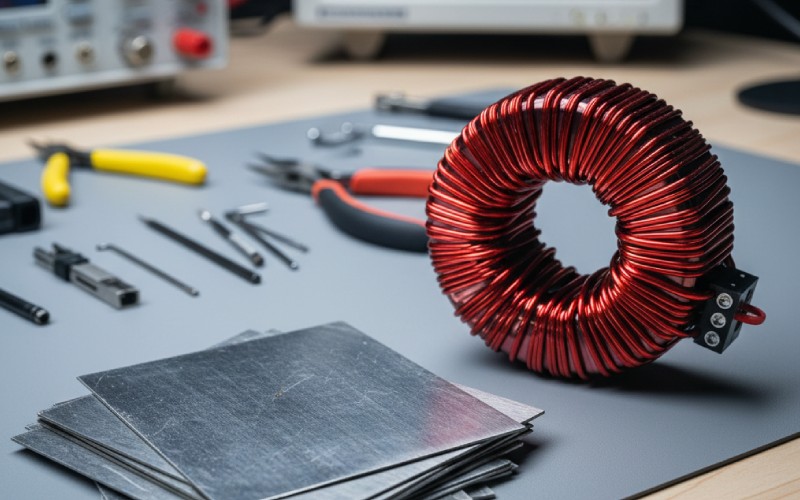Lassen Sie Sino's Lamination Stacks Ihr Projekt verstärken!
Um Ihr Projekt zu beschleunigen, können Sie Lamination Stacks mit Details wie Toleranz, Material, Oberflächengüte, ob eine oxidierte Isolierung erforderlich ist oder nicht, Mengeund mehr.

Haben Sie sich jemals gefragt, warum ein Transformator so gut funktioniert? Die Schlüsselidee liegt im Inneren. Er befindet sich in einem Teil, das Transformatorenkern genannt wird. Das Wichtigste an diesem Kern ist eine besondere Eigenschaft, die Permeabilität. In diesem Artikel erfährst du, was Permeabilität ist. Sie werden auch erfahren, warum sie so wichtig ist. Wenn du die Permeabilität eines Kernmaterials kennst, wird es dir helfen zu verstehen, wie Transformatoren funktionieren. Sie werden erfahren, warum einige besser sind als andere. Und Sie werden wissen, wie Sie den richtigen Transformator für Ihren Stromkreis auswählen.
Denken Sie an ein Papierhandtuch. Manche Papierhandtücher können viel Wasser aufsaugen. Andere können überhaupt nicht viel aufsaugen. Mit der magnetischen Permeabilität verhält es sich ähnlich, nur dass sie für Magnetfelder und nicht für Wasser gilt. Die Permeabilität eines Materials gibt an, wie gut es ein Magnetfeld halten kann. Ein Material mit hoher Permeabilität kann eine Menge magnetischer Energie "aufsaugen". Der Transformatorkern besteht aus einem Material mit hoher Permeabilität. Dies hilft, dem Magnetfeld zu zeigen, wohin es gehen soll.
In einem Transformator fließt ein elektrischer Strom durch eine Drahtspule. Dieser Draht wird als Wicklung bezeichnet. Dieser Strom erzeugt ein magnetisches Feld. Der Kern befindet sich im Inneren dieser Spule. Die hohe Permeabilität des Kernmaterials trägt dazu bei, dass das Magnetfeld gebündelt wird. Dadurch wird das Feld sehr stark. Dieses starke Feld erzeugt dann einen Strom in einer zweiten Wicklung. Wenn der Kern nicht gut wäre, wäre das Magnetfeld schwach und würde sich ausbreiten. Ein guter Kern hilft dem Transformator, seine Aufgabe viel besser zu erfüllen. Die Permeabilität des Kerns ist ein sehr wichtiger Teil seiner Konstruktion.
Ein Kernmaterial mit hoher Permeabilität ist sehr wichtig. Es ermöglicht die Erzeugung eines starken magnetischen Flusses mit einer geringen Menge an elektrischem Strom. Dies ist vor allem aus zwei Gründen hilfreich. Erstens hilft es, Energie zu sparen. Man braucht keinen großen Strom, um den Transformator zum Laufen zu bringen. Ein geringerer Strom bedeutet, dass weniger Energie in der Schaltung verschwendet wird. Zweitens kann man einen Transformator bauen, der kleiner ist und weniger wiegt. Der Kern kann kleiner sein, weil das Material seine Aufgabe so gut erfüllt.
Die Hauptaufgabe des Transformatorkerns besteht darin, einen einfachen Pfad für den magnetischen Fluss zu schaffen. Ein Material mit hoher Permeabilität hat einen geringen "Widerstand" gegenüber dem magnetischen Fluss. Das bedeutet, dass sich der vom Primärstrom erzeugte Fluss leicht bewegen kann. Er wandert durch den Kern zur zweiten Wicklung. Diese starke Verbindung ist der Grund dafür, dass ein Transformator so gut und ohne Abfall funktioniert. Ein Kern mit höherer Permeabilität führt zu einer höheren Induktivität bei einer Spule mit der gleichen Anzahl von Windungen. Diese höhere Induktivität trägt dazu bei, den Magnetisierungsstrom niedrig zu halten. Der Magnetisierungsstrom ist der Strom, den man braucht, um den Fluss im Kern zu erzeugen.
Das Kernmaterial ist so etwas wie das Herz des Transformators. Die Wahl des Materials hat einen direkten Einfluss auf den magnetischen Fluss und den benötigten Strom. Wenn Sie eine Spannung an die Primärwicklung anlegen, beginnt ein kleiner Strom zu fließen. Diesen Strom nennt man Magnetisierungsstrom. Durch diesen Strom wird der magnetische Fluss im Kern erzeugt. Wenn das Kernmaterial eine hohe Permeabilität hat, kann ein sehr kleiner Strom eine sehr große Menge an Fluss erzeugen.
Diese Verbindung zwischen Strom und Fluss ist sehr wichtig. Ein perfekter Kern würde es ermöglichen, einen riesigen magnetischen Fluss mit fast null Strom zu erzeugen. Echte Kernmaterialien sind nicht perfekt, aber einige sind sehr gut. Ein gutes Kernmaterial sorgt dafür, dass fast der gesamte magnetische Fluss von der ersten Spule zur zweiten Spule gelangt. Dadurch funktioniert die Stromübertragung von einem Stromkreis zum nächsten sehr gut. Ein schlechtes Kernmaterial würde den magnetischen Fluss entweichen lassen. Dazu wäre mehr Strom erforderlich, und es würde Energie verschwendet. Die Impedanz der Primärwicklung ändert sich ebenfalls, da eine hohe Permeabilität eine hohe Induktivität und eine hohe induktive Impedanz verursacht.

Nicht alle Kernmaterialien werden auf dieselbe Weise hergestellt. Welches Material für eine bestimmte Aufgabe am besten geeignet ist, hängt unter anderem von den Kosten, der Häufigkeit und dem Leistungsniveau ab. Einige gängige Materialien sind für bestimmte Aufgaben viel besser geeignet als andere. Die Auswahl des Kernmaterials ist ein sehr wichtiger Schritt bei der Konstruktion.
Hier finden Sie eine Tabelle mit den gebräuchlichsten Materialien für Transformatorenkerne und deren Verwendungszweck:
| Kernmaterial | Typische Relative Durchlässigkeit | Am besten für | Warum es gut ist |
|---|---|---|---|
| Luftkern | 1 | Sehr hohe Frequenz | Es gibt keine Kernverluste bei einem Material. |
| Eisenkern | 200 – 6,000 | Niederfrequenz-Leistung | Hohe Sättigungsgrenze, nicht teuer. Der Eisenkern ist sehr verbreitet. |
| Siliziumstahl | 2,000 – 10,000 | Netzfrequenz (50/60 Hz) | Hat einen höheren spezifischen Widerstand als normales Eisen, was zur Verringerung von Wirbelströmen beiträgt. |
| Ferrit (Keramik) | 20 – 20,000+ | Hochfrequenzleistung, EMI | Hat einen sehr hohen elektrischen Widerstand. Dadurch werden Wirbelströme bei hohen Frequenzen verringert. |
| Amorphes Metall | 20,000 – 100,000 | Transformatoren mit hohem Wirkungsgrad | Hat einen sehr geringen Hystereseverlust. Das Material hat eine verwechselte Atomstruktur. |
Jedes Material hat seinen eigenen Durchlässigkeitswert. Ein Eisenkern ist eine gute Wahl für viele Niederfrequenzanwendungen. Für eine Hochfrequenzschaltung benötigen Sie ein Material wie Ferrit. Die Verwendung des falschen Kernmaterials bei einer hohen Frequenz kann viel Wärme erzeugen und große Kernverluste verursachen.
Sie fragen sich vielleicht: "Wie misst man die Permeabilität eines Kerns?" Das kann man nicht einfach herausfinden, indem man ihn ansieht. Aber es gibt einen speziellen Weg, diese wichtige Eigenschaft zu bestimmen. Man kann den Wert ermitteln, indem man eine Spule baut und einige elektrische Messungen vornimmt. Zuerst nimmt man den Kern, den man testen möchte. Dann wickelst du eine Drahtspule um ihn. Du musst wissen, wie oft der Draht um den Kern gewickelt wird. So entsteht eine einfache Induktionsspule.
Als Nächstes legen Sie eine Wechselspannung an die Wicklung an und messen den Wechselstrom, der durch sie fließt. Anhand der Spannung und des Stroms können Sie die Impedanz der Spule ermitteln. Die Impedanz einer Spule ergibt sich hauptsächlich aus ihrer Induktivität bei einer bestimmten Frequenz. Auf diese Weise kann man die Induktivität herausfinden. Es gibt eine einfache Formel, die die Induktivität, die Anzahl der Windungen, die Größe des Kerns und seine Permeabilität miteinander verbindet. Sie können die Formel umstellen, um die Permeabilität des Kernmaterials zu bestimmen. Diese Methode zur Messung der magnetischen Eigenschaften ist sehr hilfreich. Um sie richtig zu messen, muss man den Strom niedrig halten. Dadurch wird der Kern nicht in die Sättigung getrieben.
Die B-H-Kurve ist ein besonderes Diagramm. Sie sagt alles über ein magnetisches Kernmaterial aus. Sie ist ein sehr nützliches Hilfsmittel. Das "H" auf der unteren Linie ist die magnetische Feldstärke. Sie können sich das als die Arbeit vorstellen, die Sie leisten. Sie wird durch den Strom in der Spule erzeugt. Das "B" auf der Linie, die an der Seite nach oben verläuft, ist die Flussdichte. Dies ist das Ergebnis deiner Arbeit. Es zeigt, wie viel magnetischer Fluss in den Kern gepresst wird.
Ein gutes Kernmaterial liefert Ihnen ein großes Ergebnis (B) für nur ein wenig Arbeit (H). Das bedeutet, dass die B-H-Kurve dort, wo sie beginnt, sehr steil ist. Wie steil die Linie auf dieser Kurve ist, ist die Permeabilität. Eine Linie, die schneller ansteigt, bedeutet eine höhere Permeabilität. Die B-H-Kurve zeigt Ihnen auch die Sättigungsgrenze an. Ab einem bestimmten Punkt wird die Linie im Diagramm flach. Das bedeutet, dass selbst wenn Sie mehr Strom schicken, nicht viel mehr Fluss in den Kern gelangen kann. Der Kern ist voll, was als Sättigung bezeichnet wird. Anhand dieser Kurve können Sie den Grenzwert Ihres Kerns erkennen. Diese bh-Kurve sieht für jede Art von Material anders aus.
Die Frequenz des Wechselstroms macht einen sehr großen Unterschied für einen Transformatorkern. Ein Kernmaterial, das bei einer niedrigen Frequenz sehr gut funktioniert, kann bei einer hohen Frequenz sehr schlecht sein. Dies geschieht aufgrund von Kernverlusten. Bei einer höheren Frequenz werden einige Arten von Energieverlusten innerhalb des Kerns viel größer. Diese verlorene Energie wird in Wärme umgewandelt. Wärme ist schlecht für den Transformatorstromkreis.
Die beiden größten Probleme bei hohen Frequenzen sind Hysterese und Wirbelströme. Hystereseverluste entstehen, weil es Energie erfordert, das Magnetfeld im Kern hin und her zu drehen. Dies geschieht bei jedem Zyklus des Wechselstroms immer wieder. Das andere Problem sind Wirbelströme. Dabei handelt es sich um kleine elektrische Ströme, die sich im Kernmaterial selbst im Kreis drehen. Sie werden durch den wechselnden magnetischen Fluss erzeugt. Diese Ströme verrichten keine gute Arbeit. Sie erzeugen nur Wärme und verschwenden Strom. Materialien wie Ferrit haben einen sehr hohen elektrischen Widerstand, oder Resistivität. Diese Eigenschaft hilft, Wirbelströme zu stoppen. Das macht sie zu einer guten Wahl für Hochfrequenzanwendungen. Ein Eisenkern würde bei einer hohen Frequenz sehr heiß werden.
Kernverluste sind wie eine Steuer auf die Energie, die Ihr Transformator verbraucht. Sie sind die Energie, die im Kern verloren geht. Der größte Teil dieser verlorenen Energie wird zu Wärme. Ein Transformator, der hohe Kernverluste hat, ist nicht sehr gut in seiner Arbeit. Sie sollten ein Kernmaterial wählen, das für die von Ihnen verwendete Frequenz niedrige Kernverluste aufweist. Die Permeabilität hängt damit zusammen, aber eine hohe Permeabilität bedeutet nicht immer, dass die Verluste gering sind.
Es gibt zwei Hauptarten von Kernverlusten, die Sie kennen sollten:
Die Auswahl eines Kernmaterials mit Eigenschaften, die diese Verluste verringern, ist sehr wichtig. Das richtige Kernmaterial bietet eine hohe Permeabilität und niedrige Kernverluste bei der Frequenz, bei der es eingesetzt wird.

Es gibt zwei Bezeichnungen für die Durchlässigkeit: relativ und absolut. Sie sind miteinander verbunden, aber sie messen die Dinge auf eine etwas andere Weise. Es ist leicht, den Unterschied zu verstehen. Absolute Durchlässigkeit ist die Durchlässigkeit des leeren Raums oder des Vakuums. Sie ist eine grundlegende Zahl in der Wissenschaft, die sich nicht ändert. Ihr Symbol ist μ₀. Sie hat einen sehr kleinen, festen Wert. Sie ist der Ausgangspunkt für die Messung aller Magnetfelder.
Relative Durchlässigkeit ist das, wovon man gewöhnlich spricht, wenn man über ein Kernmaterial spricht. Sein Symbol ist μᵣ. Sie gibt an, um wie viel besser ein Material den magnetischen Fluss leiten kann, wenn man es mit dem leeren Raum vergleicht. Wenn ein Material beispielsweise eine relative Permeabilität von 2.000 hat, bedeutet dies, dass es ein Magnetfeld 2.000 Mal besser bündeln kann als der leere Raum. Die absolute Permeabilität eines Materials lässt sich mit einer einfachen Formel ermitteln. Man multipliziert einfach seine relative Permeabilität mit der absoluten Permeabilität des Vakuums. Für die meisten Aufgaben benötigen Sie jedoch die relative Permeabilität. Damit können Sie ein Kernmaterial mit einem anderen vergleichen.
Die Auswahl des richtigen Magnetkerns mag schwierig erscheinen. Aber es ist ganz einfach, wenn Sie die richtigen Fragen stellen können. Sie müssen das Kernmaterial und seine Form auf die Aufgabe abstimmen, die Ihr Schaltkreis zu erfüllen hat. Ein guter Kern gibt Ihnen die Induktivität, die Sie brauchen. Er kann auch die richtige Stromstärke verarbeiten, ohne in die Sättigung zu geraten. Und er wird die Kernverluste niedrig halten. Die Form des Kerns (z. B. ein Ringkern oder ein Topfkern) ist ebenfalls Teil der Konstruktion.
Hier sind die wichtigsten Punkte, die Sie bei der Auswahl eines Kerns beachten sollten:
Diese Überlegungen werden Ihnen helfen, den besten Kern für Ihren Stromkreis auszuwählen. Der richtige Kern sorgt dafür, dass Ihre Drosselspule oder Ihr Transformator genau so funktioniert, wie Sie es wünschen.